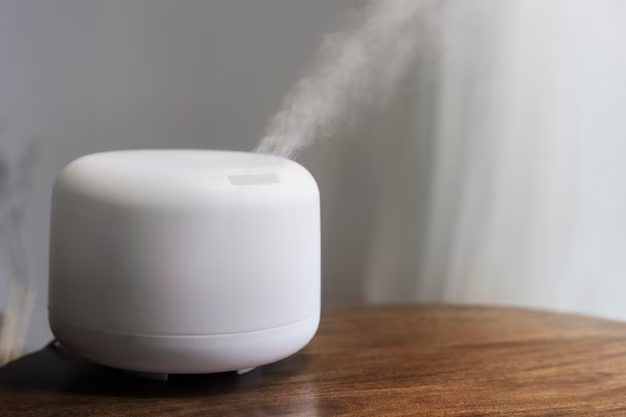In the quest for creating a comfortable indoor environment, ultrasonic humidifiers have emerged as a silent yet powerful tool. One might wonder exactly “ultrasonic humidifier how it works”; as the name suggests, these ingenious devices work primarily through ultrasonic technology. They use high-frequency sound waves, inaudible to the human ear, to break down water into a fine mist that is then dispersed into the air, thereby increasing humidity levels and improving air quality. The main topic of this article is to unveil the inner workings and benefits of ultrasonic humidifiers, offering a snapshot of their operation and contributions to indoor comfort.
Introduction to Ultrasonic Humidifiers
When considering how to use an ultrasonic humidifier, it starts with understanding what it is and what it does. An ultrasonic humidifier uses ultrasonic sound waves to break down water particles and release them as a micro-fine mist into the air. This technology allows for a quiet operation, which is one of the many appealing factors for those in need of a restful environment in places like bedrooms and offices. As opposed to other humidifiers which might employ the use of rotating disks or heating elements, the ultrasonic model is more energy-efficient and produces a cool mist, which eliminates concerns about hot steam accidents.
Among the many benefits of an ultrasonic humidifier how it works to promote your well-being, maintaining optimal humidity levels is paramount. They combat dryness that may lead to irritation in several parts of the body, from nasal passages to the skin, all while ensuring the longevity of wooden furniture and the well-being of indoor plants.
Comparing ultrasonic humidifiers to other types—such as an evaporative or steam vaporizers—a few key differences stand out:
- Noise levels: Ultrasonic humidifiers surpass others in quietness, especially compared to evaporative units that use a fan to blow air through a wet wick filter, and steam humidifiers which boil water to produce moist heat.
- Temperature of mist: Ultrasonic units typically generate cool mist, whereas steam humidifiers heat the water to create steam, which can be preferred in cooler climates yet not without a risk for burns.

Behind the Mist: The Functioning of Ultrasonic Humidifiers
A closer look at “ultrasonic humidifier how it works” reveals the essential components that operate seamlessly together: a water tank, a vibrating nebulizer known as the ultrasonic plate, a fan, and often a demineralization cartridge to prevent mineral buildup. The ultrasonic plate or membrane vibrates at an ultrasonic frequency, the ultrasonic humidifier frequency, which is key to transforming the water into mist.
The ultrasonic humidifier frequency is central to the operation of the device. These vibrations are responsible for creating the high-frequency oscillations that turn the water into minute particles, which then become a fine and absorbable mist. The whole process redefines subtlety in mechanical operation and offers an alternative approach to managing room humidity with pinpoint accuracy.
| Component | Function |
|---|---|
| Water Tank | Stores water and serves as the starting point of the humidification process. |
| Ultrasonic Plate | Vibrates at an ultrasonic humidifier frequency to atomize the water. |
| Fan | Facilitates the dispersal of fine mist into the air. |
| Control Panel | Provides user control over the device’s settings for personalized comfort. |
| Demineralization Cartridge | Filters minerals to prevent white dust, benefiting the device’s lifespan and air quality. |
Step-by-Step Guide: From Water to Mist
The transformation from water to mist is gracefully handled through several stages:
Step 1: Water Reservoir and Maintenance
So how do you start? How to use an ultrasonic humidifier involves first ensuring the water tank is properly filled. It’s crucial to use clean water and maintain tank hygiene to mitigate mineral deposits and reduce the risk of microbes. Routine cleanings and the periodic use of distilled or demineralized water can significantly benefit the unit’s longevity and the hygiene of the mist being emitted.
Step 2: The Ultrasonic Frequencies’ Generation
Once the reservoir is prepared and the humidifier is activated, the device comes to life as the ultrasonic humidifier frequency comes into play. This high-frequency vibration causes the water molecules to break apart, creating an ultra-fine, nearly invisible mist—a mesmerizing display of physics in action.
Step 3: The Creation of Mist and Its Emission
The newly generated mist is now ready for release into the room. A strategically designed fan within the humidifier aids in the efficient spread of the mist, ensuring it reaches far and wide to effectively balance the room’s humidity levels without leading to over-saturation or moisture build-up on surfaces.
Through the first segment of our in-depth exploration of ultrasonic humidifiers, we have traversed the foundational aspects of these devices: from the nuanced process of how they quietly and effectively maintain room humidity, to ultrasonic frequencies’ crucial role, and finally, to the step-by-step procedure as water is turned into mist. The forthcoming sections will dive even deeper into the unique advantages and considerations, along with some final advice to ascertain if an ultrasonic humidifier is the perfect addition to your living or workspace.

Advantages and Considerations of Ultrasonic Humidifiers
Health and Comfort: The Advantages
- Allergy and Asthma Relief: By maintaining the balance of moisture in the air, ultrasonic humidifiers can alleviate the symptoms of allergies and asthma as the clean mist can help to soothe irritated airways.
- Skin Hydration: Dry air can lead to dehydrated skin. Having an ultrasonic humidifier increases the moisture level in the air, which helps to keep skin moisturized and supple.
Besides these health benefits, ultrasonic humidifiers are also praised for their convenience. With their silent operation, they do not disturb sleep or daily activities. Moreover, many models come with adjustable settings, allowing users to control the humidity levels with ease.
Maintenance and Safety Considerations
- Cleaning: To ensure that the mist emitted is always clean and safe to breathe, regular cleaning of the humidifier is essential. Stagnant water can breed mold and bacteria, which can be harmful if dispersed into the air.
- Mineral Dust: If tap water is used, minerals present in the water can deposit as white dust around the room. Using distilled water or demineralization cartridges can help minimize this issue.
One substantial consideration is the need for a hygrometer to monitor humidity levels. Too much humidity can be just as problematic as not enough, leading to condensation on windows, mold growth, and an uncomfortable atmosphere.
Selecting the Right Ultrasonic Humidifier for Your Needs
The market is flooded with a variety of ultrasonic humidifiers, and choosing the right one can be overwhelming. Here are a few factors to keep in mind before making a purchase:
- Room Size: Ensure the humidifier’s output matches the size of the room where it will be used. A larger capacity unit is necessary for a bigger space, while a compact model suffices for a smaller area.
- Feature Set: Look for features that suit your lifestyle, like automatic shut-off, ease of cleaning, and the inclusion of a hygrometer or humidistat.
Tips for Proper Usage and Care
- Always follow the manufacturer’s instructions for use and maintenance.
- Change the water daily to prevent microbial growth and use demineralized or distilled water if possible.
- Clean your ultrasonic humidifier regularly, according to the schedule suggested by the manufacturer.
By considering these factors and adhering to proper care guidelines, your ultrasonic humidifier can serve you effectively for many years.

Conclusion: Is an Ultrasonic Humidifier Right for You?
In conclusion, an ultrasonic humidifier can be a remarkable addition to your home or office, offering customizability, silent operation, and health benefits. Weighing its advantages against the necessary considerations will help you decide if this is the right investment for your indoor air quality needs.
FAQs About Ultrasonic Humidifiers
How often should I clean my ultrasonic humidifier?
It’s advisable to empty the water reservoir and wipe it down daily. A thorough cleaning should be done once a week to remove any mineral deposits or microbial buildup.
Can I use essential oils in my ultrasonic humidifier?
Not all ultrasonic humidifiers are designed to be used with essential oils as the oil can damage the ultrasonic plate. Check the manufacturer’s recommendations before adding any oils to your humidifier.
What’s the best way to prevent white dust when using an ultrasonic humidifier?
Utilizing distilled or demineralized water can drastically cut down on the white dust produced. Additionally, some models come with built-in water filters or demineralization cartridges specifically for this purpose.
Is it possible to over-humidify a room with an ultrasonic humidifier?
Yes, it’s possible to add too much moisture to the air, which is why it’s beneficial to use a hygrometer to monitor humidity levels and maintain them within the optimum range of 30-50%.
How do I know if my ultrasonic humidifier is working correctly?
You should notice an increase in the room’s humidity level soon after the humidifier is turned on. Many models include indicators or built-in hygrometers to display the current humidity level. If you’re not seeing a change or mist output, there may be an issue with the unit’s operation.



